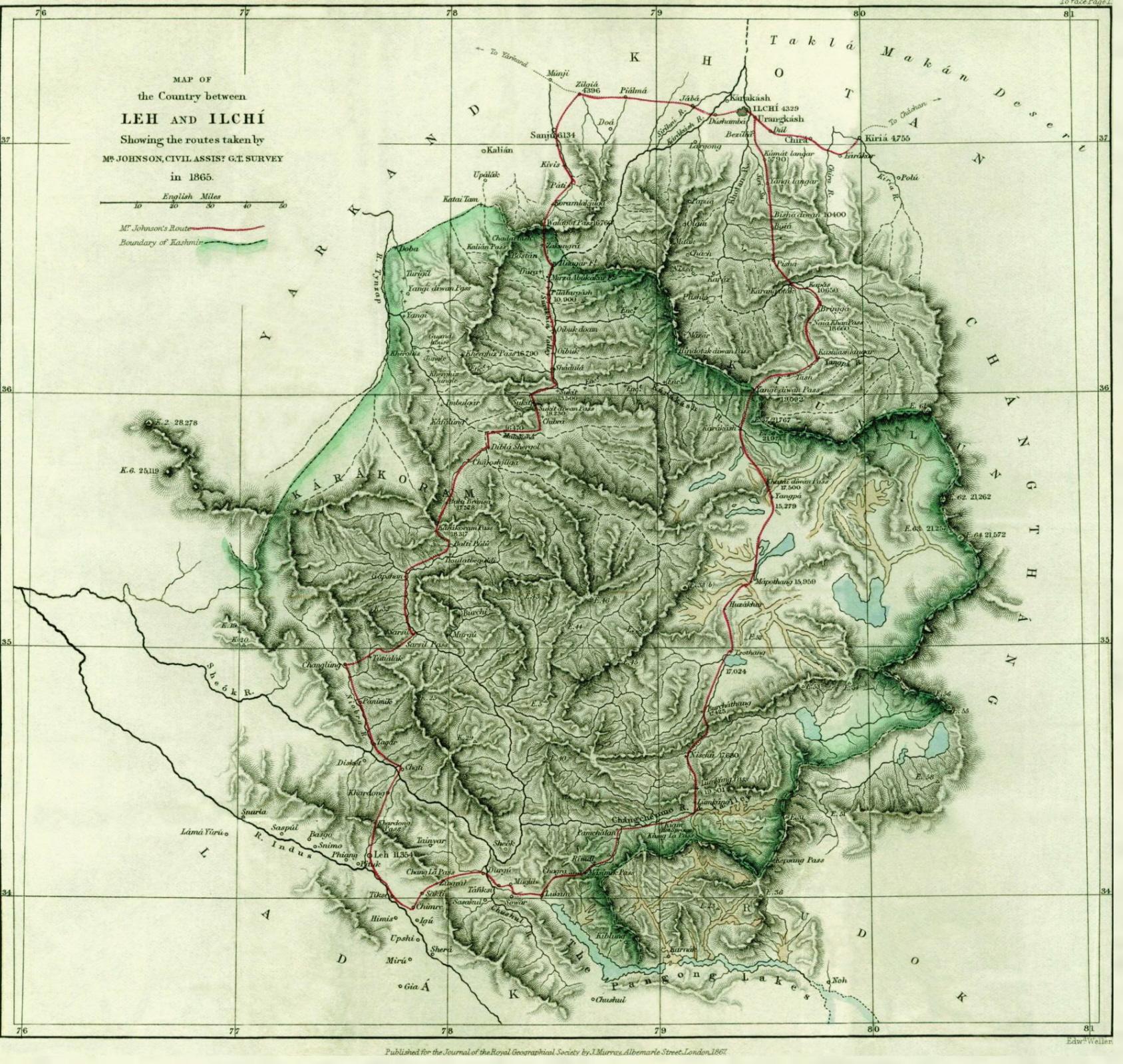|
Hindutash
Hindu-tagh Pass, also known as Hindutash, is a historical mountain pass in the western Xinjiang, China. The pass cuts through the Kunlun Mountains connecting the now-deserted town of Kangxiwar in the Karakash River valley to the town of Pusha in the Pusha Jilga valley (; formerly Bushia). It also connects to the road to the city of Hotan (formerly Khotan or Ilchi; see adjacent maps). is under construction connecting Kangxiwar directly with Hotan. It will tunnel under Hindutash, connect with the Xinjiang-Tibet Highway G219 to the south after numerous hairpin turns. It is scheduled to be completed in 2022. "Hindu-tagh" means "Indian Mountain," and "Hindu-tash," "Indian stone" in the Uyghur dialect of Xinjiang. History In 1857, the explorer Robert Schlagintweit crossed this pass from camping grounds in Sumgal ("three fords"), on the banks of the Karakash river, approximately upstream from Kengshewar and estimated its height to be . At the top of the pass (), there is a ... [...More Info...] [...Related Items...] OR: [Wikipedia] [Google] [Baidu] |
Sumgal
Kangxiwar (; ) is the location of a deserted town on the southwest side of the Kunlun Mountains. It is on the bank of the Karakash River in the western Xinjiang Uyghur Autonomous Region of the People's Republic of China. It is also the base of the route to Hotan from the Karakash valley via the Hindutash pass. According to Chinese sources, Kangxiwar means "place with mine" in Uyghur. During the Sino-Indian War of 1962, Kangxiwar served as the forward headquarters for the Xinjiang Military Command. The military cemetery of those killed in the war is still located here. There is also a highway maintenance crew house at Kangxiwar at the present time. China National Highway 219 (G219), the Xinjiang-Tibet Highway, runs through here. Following the G219 southeast will lead to Dahongliutan and Tianshuihai, the latter of which is in Aksai Chin. China National Highway 580 is under construction connecting Kangxiwar directly with Hotan. It is scheduled to be completed in 2022. ''Kangxiw ... [...More Info...] [...Related Items...] OR: [Wikipedia] [Google] [Baidu] |
Hotan
Hotan (also known by other names) is a major oasis town in southwestern Xinjiang, an autonomous region in Northwestern China. The city proper of Hotan broke off from the larger Hotan County to become an administrative area in its own right in August 1984. It is the seat of Hotan Prefecture. With a population of 408,900 (2018 census), Hotan is situated in the Tarim Basin some southwest of the regional capital, Ürümqi. It lies just north of the Kunlun Mountains, which are crossed by the Sanju, Hindutash and Ilchi passes. The town, located southeast of Yarkant County and populated almost exclusively by Uyghurs, is a minor agricultural center. An important station on the southern branch of the historic Silk Road, Hotan has always depended on two strong rivers, the Karakash River and the White Jade River, to provide the water needed to survive on the southwestern edge of the vast Taklamakan Desert. The White Jade River still provides water and irrigation for the town and o ... [...More Info...] [...Related Items...] OR: [Wikipedia] [Google] [Baidu] |
Sanju Pass
The Sanju, or Sanju-la (), with an elevation of , is a historical mountain pass in the Kun Lun Mountains in Pishan County, Hotan Prefecture, Xinjiang, China. During ancient times, it was the last on a series of difficult passes on the most common summer caravan route between Ladakh and the Tarim Basin. In recent years, besides being used by the locals, it has also become a trekking route for Chinese trekkers. In early 2020s, a scenic unpaved auto tour route was opened along the trail for road trippers. Geography and caravan routes Historically, the main route from Northern India to the Tarim Basin led through the Nubra Valley in Ladakh across the ice-covered Sasser Pass () and the even higher Karakoram Pass () and the relatively easy Suget Pass to the staging post at Shahidulla. From there in summer the caravans normally headed north across the Sanju Pass to modern Guma (Pishan) in the Tarim Basin and then either northwest to Karghalik and Yarkand or northeast to K ... [...More Info...] [...Related Items...] OR: [Wikipedia] [Google] [Baidu] |
Aksai Chin
Aksai Chin is a region administered by China partly in Hotan County, Hotan Prefecture, Xinjiang, and partly in Rutog County, Ngari Prefecture, Tibet Autonomous Region, Tibet, and constituting the easternmost portion of the larger Kashmir region that has been the subject of a dispute between India and China since 1959. The application of the term "administered" to the various regions of Kashmir and a mention of the Kashmir dispute is supported by the WP:TERTIARY, tertiary sources (a) through (e), reflecting WP:DUE, due weight in the coverage. Although "controlled" and "held" are also applied neutrally to the names of the disputants or to the regions administered by them, as evidenced in sources (h) through (i) below, "held" is also considered politicized usage, as is the term "occupied," (see (j) below). (a) (subscription required) Quote: "Kashmir, region of the northwestern Indian subcontinent ... has been the subject of dispute between India and Pakistan since the partition o ... [...More Info...] [...Related Items...] OR: [Wikipedia] [Google] [Baidu] |
Yurungkash
__NOTOC__ The White Jade River, also known by the native names Baiyu or Yurungkash, is a river in the southern Xinjiang region of China. The head waters of the river rise in the Kunlun Mountains, in the area of Aksai Chin in Kashmir in the Togatax area (). The river flows east for some 200 km and then north for another 200 km before passing through Khotan, China (). In Khotan, the river has yielded white river rocks which are also known as nephrite jade. North of Khotan, it eventually dries up in the Taklamakan Desert, its seasonal bed joined by that of the Black Jade River (Karakash River) near Koxlax (some 200 km north of Khotan, ), from where it continues north as the Hotan River, which flows into the Tarim River. The river drains an area of and has a discharge of . The river gets its name from the white jade that is often found in its alluvial deposits. The jade can also however be found in semi-shallow areas of the river.. Roads * China local highway S216 follows the ... [...More Info...] [...Related Items...] OR: [Wikipedia] [Google] [Baidu] |
Aurel Stein
Sir Marc Aurel Stein, (; 26 November 1862 – 26 October 1943) was a Hungarian-born British archaeologist, primarily known for his explorations and archaeological discoveries in Central Asia. He was also a professor at Indian universities. Stein was also an ethnographer, geographer, linguist and surveyor. His collection of books and manuscripts bought from Dunhuang caves is important for the study of the history of Central Asia and the art and literature of Buddhism. He wrote several volumes on his expeditions and discoveries which include ''Ancient Khotan'', ''Serindia'' and ''Innermost Asia''. Early life Stein was born to Náthán Stein and Anna Hirschler, a Jewish couple residing in Budapest in the Kingdom of Hungary, Austrian Empire. His parents and his sister retained their Jewish faith but Stein and his brother, Ernst Eduard, were baptised as Lutherans. At home the family spoke German and Hungarian, Stein graduated from a secondary school in Budapest before going on ... [...More Info...] [...Related Items...] OR: [Wikipedia] [Google] [Baidu] |
Central Intelligence Agency
The Central Intelligence Agency (CIA; ) is a civilian foreign intelligence service of the federal government of the United States tasked with advancing national security through collecting and analyzing intelligence from around the world and conducting covert operations. The agency is headquartered in the George Bush Center for Intelligence in Langley, Virginia, and is sometimes metonymously called "Langley". A major member of the United States Intelligence Community (IC), the CIA has reported to the director of national intelligence since 2004, and is focused on providing intelligence for the president and the Cabinet. The CIA is headed by a director and is divided into various directorates, including a Directorate of Analysis and Directorate of Operations. Unlike the Federal Bureau of Investigation (FBI), the CIA has no law enforcement function and focuses on intelligence gathering overseas, with only limited domestic intelligence collection. The CIA is responsibl ... [...More Info...] [...Related Items...] OR: [Wikipedia] [Google] [Baidu] |
Kashmir Region
Kashmir ( or ) is the northernmost geographical region of the Indian subcontinent. Until the mid-19th century, the term ''Kashmir'' denoted only the Kashmir Valley between the Great Himalayas and the Pir Panjal Range. The term has since also come to encompass a larger area that includes the Indian-administered territories of Jammu and Kashmir and Ladakh, the Pakistani-administered territories of Azad Kashmir and Gilgit-Baltistan, and the Chinese-administered territories of Aksai Chin and the Trans-Karakoram Tract. Quote: "Kashmir, region of the northwestern Indian subcontinent. It is bounded by the Uygur Autonomous Region of Xinjiang to the northeast and the Tibet Autonomous Region to the east (both parts of China), by the Indian states of Himachal Pradesh and Punjab to the south, by Pakistan to the west, and by Afghanistan to the northwest. The northern and western portions are administered by Pakistan and comprise three areas: Azad Kashmir, Gilgit, and Baltistan, . ... [...More Info...] [...Related Items...] OR: [Wikipedia] [Google] [Baidu] |
Hermann Schlagintweit
Hermann Schlagintweit, Sakünlünski (13 May 1826 – 19 January 1882), also known as Hermann Rudolph Alfred von Schlagintweit-Sakünlünski, was a German explorer of Central Asia. Brothers Hermann, Adolph and Robert Schlagintweit were commissioned by the British East India Company to study the Earth's magnetic field in South and Central Asia. They were the first Europeans to cross the Kunlun Mountains and the first to explore the region between Karakoram and Kunlun. Life The eldest of the five Schlagintweit brothers of Munich, along with his brother Adolf, he published a scientific study of the Alps in 1846–1848. They established their reputation with the ''Untersuchungen über die physikalische Geographie der Alpen'' (1850), and were afterwards joined by brother Robert, and jointly published ''Neue Untersuchungen über die physikalische Geographie und Geologie der Alpen'' in 1854. In 1854, acting on the recommendation of Alexander von Humboldt, the East India Company ... [...More Info...] [...Related Items...] OR: [Wikipedia] [Google] [Baidu] |
Survey Of India
The Survey of India is India's central engineering agency in charge of mapping and surveying.On 250th birthday, Survey of India wants to shed its cloak of secrecy , . Set up in 1767St. Peter Church Allahabad . to help consolidate the territories of the |
William Johnson (surveyor)
William H. Johnson (died 3 March 1883) was a British surveyor in the Great Trigonometric Survey of India. He is noted for the first definition of the eastern boundary of Ladakh along Aksai Chin in the princely state of Jammu and Kashmir, which has come to be called the ' Johnson Line'. After retiring from the Survey of India, Johnson was appointed as the Governor of Ladakh, in which position he served until his death. Early life Johnson was born in India to an Ordinance officer of the East India Company, who lived in "Deyrah". He was educated at Mussorie and joined the Civil Branch of the Great Trigonometric Survey (the precursor of the Survey of India), where he was trained by Andrew Scott Waugh. Career Johnson began his career as a surveyor in 1848 under Captain du Vernet in the North-West Himalayan Survey. After du Vernet moved to Assam in 1852, he worked for some time doing route surveys in Punjab, then the survey of the Chenab River, and the survey of Bhagirathi and Kanawa ... [...More Info...] [...Related Items...] OR: [Wikipedia] [Google] [Baidu] |







